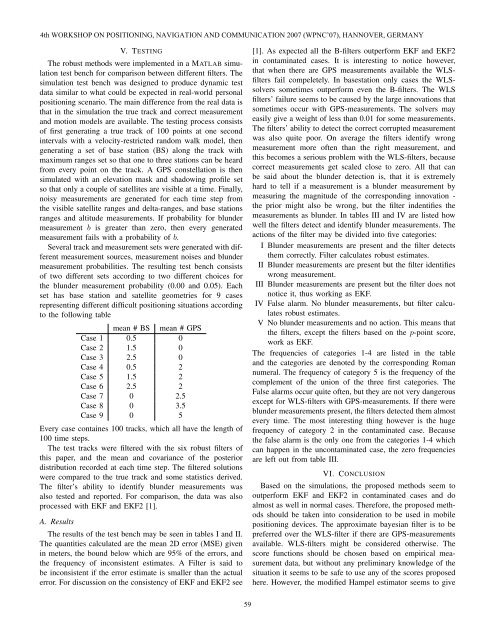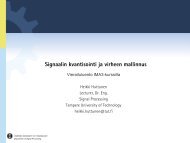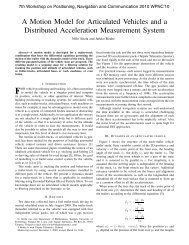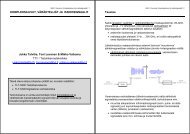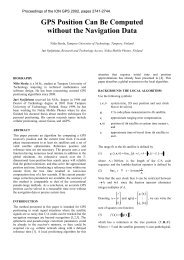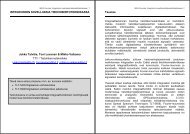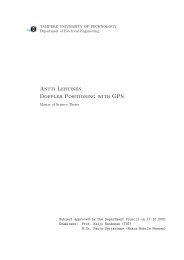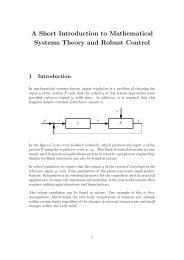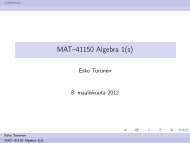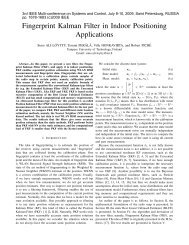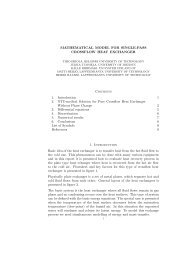Robust Extended Kalman Filtering in Hybrid Positioning Applications
Robust Extended Kalman Filtering in Hybrid Positioning Applications
Robust Extended Kalman Filtering in Hybrid Positioning Applications
You also want an ePaper? Increase the reach of your titles
YUMPU automatically turns print PDFs into web optimized ePapers that Google loves.
4th WORKSHOP ON POSITIONING, NAVIGATION AND COMMUNICATION 2007 (WPNC’07), HANNOVER, GERMANY<br />
V. TESTING<br />
The robust methods were implemented <strong>in</strong> a MATLAB simulation<br />
test bench for comparison between different filters. The<br />
simulation test bench was designed to produce dynamic test<br />
data similar to what could be expected <strong>in</strong> real-world personal<br />
position<strong>in</strong>g scenario. The ma<strong>in</strong> difference from the real data is<br />
that <strong>in</strong> the simulation the true track and correct measurement<br />
and motion models are available. The test<strong>in</strong>g process consists<br />
of first generat<strong>in</strong>g a true track of 100 po<strong>in</strong>ts at one second<br />
<strong>in</strong>tervals with a velocity-restricted random walk model, then<br />
generat<strong>in</strong>g a set of base station (BS) along the track with<br />
maximum ranges set so that one to three stations can be heard<br />
from every po<strong>in</strong>t on the track. A GPS constellation is then<br />
simulated with an elevation mask and shadow<strong>in</strong>g profile set<br />
so that only a couple of satellites are visible at a time. F<strong>in</strong>ally,<br />
noisy measurements are generated for each time step from<br />
the visible satellite ranges and delta-ranges, and base stations<br />
ranges and altitude measurements. If probability for blunder<br />
measurement b is greater than zero, then every generated<br />
measurement fails with a probability of b.<br />
Several track and measurement sets were generated with different<br />
measurement sources, measurement noises and blunder<br />
measurement probabilities. The result<strong>in</strong>g test bench consists<br />
of two different sets accord<strong>in</strong>g to two different choices for<br />
the blunder measurement probability (0.00 and 0.05). Each<br />
set has base station and satellite geometries for 9 cases<br />
represent<strong>in</strong>g different difficult position<strong>in</strong>g situations accord<strong>in</strong>g<br />
to the follow<strong>in</strong>g table<br />
mean # BS mean # GPS<br />
Case 1 0.5 0<br />
Case 2 1.5 0<br />
Case 3 2.5 0<br />
Case 4 0.5 2<br />
Case 5 1.5 2<br />
Case 6 2.5 2<br />
Case 7 0 2.5<br />
Case 8 0 3.5<br />
Case 9 0 5<br />
Every case conta<strong>in</strong>es 100 tracks, which all have the length of<br />
100 time steps.<br />
The test tracks were filtered with the six robust filters of<br />
this paper, and the mean and covariance of the posterior<br />
distribution recorded at each time step. The filtered solutions<br />
were compared to the true track and some statistics derived.<br />
The filter’s ability to identify blunder measurements was<br />
also tested and reported. For comparison, the data was also<br />
processed with EKF and EKF2 [1].<br />
A. Results<br />
The results of the test bench may be seen <strong>in</strong> tables I and II.<br />
The quantities calculated are the mean 2D error (MSE) given<br />
<strong>in</strong> meters, the bound below which are 95% of the errors, and<br />
the frequency of <strong>in</strong>consistent estimates. A Filter is said to<br />
be <strong>in</strong>consistent if the error estimate is smaller than the actual<br />
error. For discussion on the consistency of EKF and EKF2 see<br />
59<br />
[1]. As expected all the B-filters outperform EKF and EKF2<br />
<strong>in</strong> contam<strong>in</strong>ated cases. It is <strong>in</strong>terest<strong>in</strong>g to notice however,<br />
that when there are GPS measurements available the WLSfilters<br />
fail compeletely. In basestation only cases the WLSsolvers<br />
sometimes outperform even the B-filters. The WLS<br />
filters’ failure seems to be caused by the large <strong>in</strong>novations that<br />
sometimes occur with GPS-measurements. The solvers may<br />
easily give a weight of less than 0.01 for some measurements.<br />
The filters’ ability to detect the correct corrupted measurement<br />
was also quite poor. On average the filters identify wrong<br />
measurement more often than the right measurement, and<br />
this becomes a serious problem with the WLS-filters, because<br />
correct measurements get scaled close to zero. All that can<br />
be said about the blunder detection is, that it is extremely<br />
hard to tell if a measurement is a blunder measurement by<br />
measur<strong>in</strong>g the magnitude of the correspond<strong>in</strong>g <strong>in</strong>novation -<br />
the prior might also be wrong, but the filter <strong>in</strong>dentifies the<br />
measurements as blunder. In tables III and IV are listed how<br />
well the filters detect and identify blunder measurements. The<br />
actions of the filter may be divided <strong>in</strong>to five categories:<br />
I Blunder measurements are present and the filter detects<br />
them correctly. Filter calculates robust estimates.<br />
II Blunder measurements are present but the filter identifies<br />
wrong measurement.<br />
III Blunder measurements are present but the filter does not<br />
notice it, thus work<strong>in</strong>g as EKF.<br />
IV False alarm. No blunder measurements, but filter calculates<br />
robust estimates.<br />
V No blunder measurements and no action. This means that<br />
the filters, except the filters based on the p-po<strong>in</strong>t score,<br />
work as EKF.<br />
The frequencies of categories 1-4 are listed <strong>in</strong> the table<br />
and the categories are denoted by the correspond<strong>in</strong>g Roman<br />
numeral. The frequency of category 5 is the frequency of the<br />
complement of the union of the three first categories. The<br />
False alarms occur quite often, but they are not very dangerous<br />
except for WLS-filters with GPS-measurements. If there were<br />
blunder measurements present, the filters detected them almost<br />
every time. The most <strong>in</strong>terest<strong>in</strong>g th<strong>in</strong>g however is the huge<br />
frequency of category 2 <strong>in</strong> the contam<strong>in</strong>ated case. Because<br />
the false alarm is the only one from the categories 1-4 which<br />
can happen <strong>in</strong> the uncontam<strong>in</strong>ated case, the zero frequencies<br />
are left out from table III.<br />
VI. CONCLUSION<br />
Based on the simulations, the proposed methods seem to<br />
outperform EKF and EKF2 <strong>in</strong> contam<strong>in</strong>ated cases and do<br />
almost as well <strong>in</strong> normal cases. Therefore, the proposed methods<br />
should be taken <strong>in</strong>to consideration to be used <strong>in</strong> mobile<br />
position<strong>in</strong>g devices. The approximate bayesian filter is to be<br />
preferred over the WLS-filter if there are GPS-measurements<br />
available. WLS-filters might be considered otherwise. The<br />
score functions should be chosen based on empirical measurement<br />
data, but without any prelim<strong>in</strong>ary knowledge of the<br />
situation it seems to be safe to use any of the scores proposed<br />
here. However, the modified Hampel estimator seems to give


